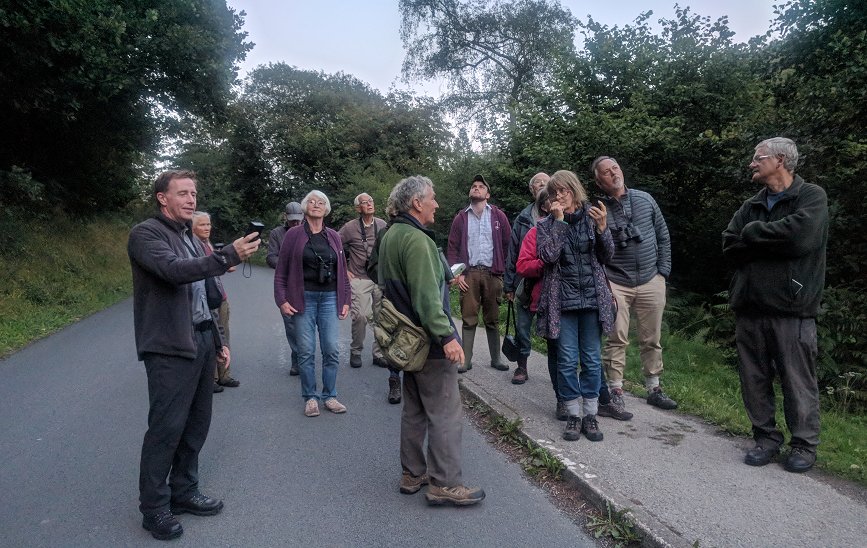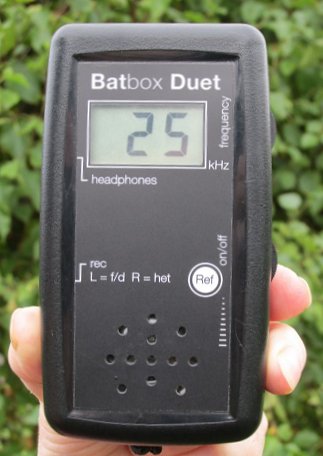
Back to the Home page

This was a joint meeting with Scarborough Nats. 14 members from both societies met at Staindale at about 8:15pm on a beautiful calm, reasonably warm evening, perfect for bats. Or so one would have thought, but the bats had other ideas and we actually recorded rather fewer than Nick Gibbons, our leader, was expecting.
 Nick had come prepared with several “bat boxes” which we tuned to different frequencies to try and pick up different species of bats, aiming to hear noctules at about 25kHz, pipistrelles at 45 or 55kHz, and Daubenton’s (the “water bat”) at about 35kHz. He explained that different species used ultrasonic calls at these different frequencies, but that things could get rather more complicated, for instance if a bat was following a moth into a more wooded area it would change its calls to avoid crashing into the trees. He also explained that some bats, notably the brown long-eared, have very quiet calls and cannot usually be picked up beyond 10m or so with the bat detectors.
Nick had come prepared with several “bat boxes” which we tuned to different frequencies to try and pick up different species of bats, aiming to hear noctules at about 25kHz, pipistrelles at 45 or 55kHz, and Daubenton’s (the “water bat”) at about 35kHz. He explained that different species used ultrasonic calls at these different frequencies, but that things could get rather more complicated, for instance if a bat was following a moth into a more wooded area it would change its calls to avoid crashing into the trees. He also explained that some bats, notably the brown long-eared, have very quiet calls and cannot usually be picked up beyond 10m or so with the bat detectors.
We started at the car park and walked slowly down the road beside the lake, and soon saw a large bat flying fairly high, with relatively slow wingbeats. This was a noctule, and its calls showed up very nicely on those detectors set to 25kHz, This bat was seen and heard several times, and appeared to be flying circuits. Nick said this was typical behaviour for a noctule, and that they were one of the earliest bats to emerge, before it gets really dark.
A few minutes later the detectors set to the higher frequencies started to pick up signals from both common and soprano pipistrelles, and we got brief glimpses of a much smaller bat flying lower with faster wingbeats. As we continued down to the dam of the lake there were several of these recorded and occasionally glimpsed, although this became harder as it was now much darker.
We stopped at the dam hoping to see Daubenton’s bats, but despite a few faint clicks from the detectors none were seen, so we retraced our steps and then stopped at a viewing platform over the water. Here we had better luck with at least one bat heard. Nick then switched on a powerful torch and swept it across the water surface like a searchlight, and occasionally we caught sight of the bat, flying low and fast over the water. It was noticeably pale underneath. Nick explained that this was one of a group of closely related Myotis species that are hard to separate on the calls alone, but the characteristic behaviour allowed him to id this confidently as a Daubenton’s. However he warned us that other bats also fly over water (and indeed the Daubenton’s can be found away from it). To prove the point we also recorded at least two passes of a pipistrelle over the lake; it seemed to be flying a little higher.
We then moved to a second viewpoint at the top of the lake where we got better views of the Daubenton’s bat (Nick thought there might only be the one, and was puzzled that there wasn’t more activity as the conditions seemed ideal), and again recorded pipistrelles flying over the water. There was also one pass of a noctule with a rather different call, probably chasing prey into the trees as explained earlier, We also heard a pipistrelle’s “social call” which is quite different from that used for navigation.
At about 10 o’clock we saw a bright shooting star and shortly afterwards called it a day and thanked Nick for a fascinating evening. I’m sure we all learned a lot and it was great to be able to have a go with the bat detectors.
| © Ryedale Natural History Society 2018, Photos © Nick Fraser, Nick Gibbons 2018 |